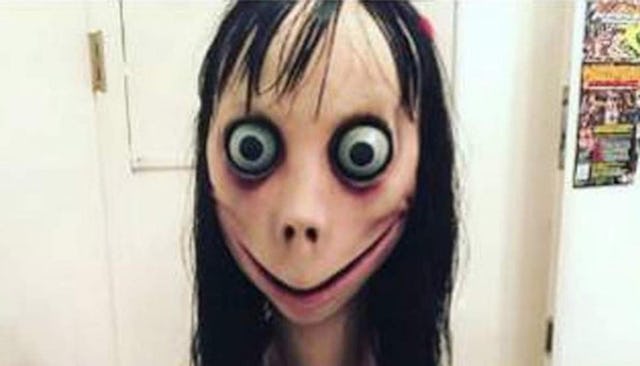Calm Down, Parents -- This 'Momo' Thing Is A Hoax

The viral “Momo” challenge has been proven to be a hoax
Unless you’ve been living under an internet rock (in which case, bless you) you’ve probably seen a thing or two about “Momo” in the last few days. It’s become something of a Facebook hysteria with countless parents sharing terrifying posts about a figure that supposedly appears on a popular chat app and instructs kids to do “challenges” that could harm or even kill them.
The good news? It’s a total hoax. The bad news? The internet is still a pretty scary place and the fear of our kids being unsafe is probably what fueled this in the first place.
Now we’ve gotta warn you — if you haven’t seen Momo yet, there’s sort of no preparing for it. I’m all about scary movies and it’s tough to make me jump, but the first time I saw its face, I cringed.
Those bulging eyes and flaring nostrils and ear-to-ear creepy grin are the stuff of nightmares. Oh, and the lack of body that ends in a set of gnarly bird feet. Once you see it you can’t unsee it, and the thought of this thing appearing onscreen and telling our kids to harm themselves is pretty horrifying.
Thankfully, it’s not actually happening.
The fable goes that kids using the WhatsApp chat app are shown “Momo,” who encourages them to add her/him as a contact, and then the character starts issuing “challenges” that could hurt them, all while telling the child to not share with their family or friends that they’re talking to Momo. Posts about the creature along with very scary screenshots have been circulating online for days, attracting thousands of shares and comments. I can’t even tell you how many well-meaning moms I’ve seen sharing the story in my Facebook feed this week. Once it took hold, it spiraled very quickly.
But according to the BBC, all this freaking out is literally over nothing, as there’s no evidence that any of the stories being told about Momo’s dangerous contact with kids eventually ending in a child’s injury or death are true. The charity Samaritans was “not aware of any verified evidence in this country or beyond.”
The hoax has been disproven by Snopes who cited ReignBot, a YouTuber who posts regularly about creepy things on the Internet, as a source. “The Momo thing is much more akin to an urban legend right now,” said ReignBot. The account posted a video about the “Momo Challenge” that has garnered more than 2 million views.
“People are claiming what Momo is and what Momo does, but not that many people have actually interacted with the account,” they said. “Finding screenshots of interactions with Momo is nearly impossible and you’d think there’d be more for such a supposedly widespread thing.”
Right. Which is a glaring clue that this is a whole lot of freakout over nothing. Which isn’t to say that it’s wrong to be scared and concerned when you hear about it — I consider myself to be pretty internet-savvy due to my line of work, but even I nervously grilled my tweenage kids the other day about Momo. Both were familiar with the legend. And both admitted they’d never seen it for themselves and neither had anyone else they knew.
But the image of Momo is very real — and didn’t appear out of nowhere. The Atlantic gave a history of the figure and how its “legend” was born. It’s actually a sculpture created by artist Keisuke Aisawa for the Japanese special-effects company Link Factory. Aisawa titled it “Mother Bird” and it was on display back in 2016 at a Tokyo horror art gallery called Vanilla Gallery. It was after photos of the piece of art were shared on a Reddit forum that the Momo urban legend was born.
But now, the actual risk, according to experts, is that the hysteria surrounding the hoax is putting some people at risk by having talk of self-harm and suicide blaring from every social media news outlet.
The viral hoax is not the first one of its kind, and sadly, it won’t be the last. The “Blue Whale” challenge of 2017 took the internet by storm with its supposed sinister goal of getting kids and teens to kill themselves. It turned out to be a hoax too. Just like the Tide Pod-eating phenomenon, condom “snorting,” and cinnamon challenges. Momo can now join this list of scary things the kids these days are doing that turned out to be nonsense.
As The Atlantic points out, these hoaxes all follow more or less the same formula into eventual irrelevance. It starts with an obscure story of something maybe, possibly happening to one kid in one town, and then, worried parents begin sharing the tale on social media making it seem a whole lot worse and more common than it is. The youths laugh at the naive adults who have yet to understand that the internet is full of lies and bullshit, the whole thing becomes a joke, and we move on to the next big, scary tale lurking on the web.
However, that isn’t to say there aren’t terrible and scary things aimed at our kids online. Just this week, we heard of mom and pediatrician Dr. Free Hess discovering “suicide instructions” inside a video for kids about a Nintendo game. It was very much real — and very much vile and scary. There’s no shortage of frightening stumbling blocks for our kids to discover online and we need to be cautious and watchful with what they have access to.
But Momo is one thing we can officially check off our list of concerns. Now to see to the other one million things.
This article was originally published on